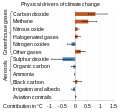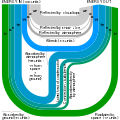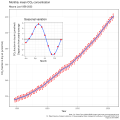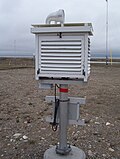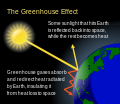Portal:Climate change
The Climate Change Portal Present-day climate change includes both global warming—the ongoing increase in global average temperature—and its wider effects on Earth’s climate system. Climate change in a broader sense also includes previous long-term changes to Earth's climate. The current rise in global temperatures is driven by human activities, especially fossil fuel burning since the Industrial Revolution. Fossil fuel use, deforestation, and some agricultural and industrial practices release greenhouse gases. These gases absorb some of the heat that the Earth radiates after it warms from sunlight, warming the lower atmosphere. Carbon dioxide, the primary gas driving global warming, has increased in concentration by about 50% since the pre-industrial era to levels not seen for millions of years. Climate change has an increasingly large impact on the environment. Deserts are expanding, while heat waves and wildfires are becoming more common. Amplified warming in the Arctic has contributed to thawing permafrost, retreat of glaciers and sea ice decline. Higher temperatures are also causing more intense storms, droughts, and other weather extremes. Rapid environmental change in mountains, coral reefs, and the Arctic is forcing many species to relocate or become extinct. Even if efforts to minimize future warming are successful, some effects will continue for centuries. These include ocean heating, ocean acidification and sea level rise. Climate change threatens people with increased flooding, extreme heat, increased food and water scarcity, more disease, and economic loss. Human migration and conflict can also be a result. The World Health Organization calls climate change one of the biggest threats to global health in the 21st century. Societies and ecosystems will experience more severe risks without action to limit warming. Adapting to climate change through efforts like flood control measures or drought-resistant crops partially reduces climate change risks, although some limits to adaptation have already been reached. Poorer communities are responsible for a small share of global emissions, yet have the least ability to adapt and are most vulnerable to climate change. Many climate change impacts have been observed in the first decades of the 21st century, with 2024 the warmest on record at +1.60 °C (2.88 °F) since regular tracking began in 1850. Additional warming will increase these impacts and can trigger tipping points, such as melting all of the Greenland ice sheet. Under the 2015 Paris Agreement, nations collectively agreed to keep warming "well under 2 °C". However, with pledges made under the Agreement, global warming would still reach about 2.8 °C (5.0 °F) by the end of the century. Limiting warming to 1.5 °C would require halving emissions by 2030 and achieving net-zero emissions by 2050. There is widespread support for climate action worldwide. Fossil fuel use can be phased out by conserving energy and switching to energy sources that do not produce significant carbon pollution. These energy sources include wind, solar, hydro, and nuclear power. Cleanly generated electricity can replace fossil fuels for powering transportation, heating buildings, and running industrial processes. Carbon can also be removed from the atmosphere, for instance by increasing forest cover and farming with methods that capture carbon in soil. (Full article...) Selected article –Sea ice in the Arctic region has declined in recent decades in area and volume due to climate change. It has been melting more in summer than it refreezes in winter. Global warming, caused by greenhouse gas forcing is responsible for the decline in Arctic sea ice. The decline of sea ice in the Arctic has been accelerating during the early twenty-first century, with a decline rate of 4.7% per decade (it has declined over 50% since the first satellite records). Summertime sea ice will likely cease to exist sometime during the 21st century. The region is at its warmest in at least 4,000 years. Furthermore, the Arctic-wide melt season has lengthened at a rate of five days per decade (from 1979 to 2013), dominated by a later autumn freeze-up. The IPCC Sixth Assessment Report (2021) stated that Arctic sea ice area will likely drop below 1 million km2 in at least some Septembers before 2050. In September 2020, the US National Snow and Ice Data Center reported that the Arctic sea ice in 2020 had melted to an extent of 3.74 million km2, its second-smallest extent since records began in 1979. Earth lost 28 trillion tonnes of ice between 1994 and 2017, with Arctic sea ice accounting for 7.6 trillion tonnes of this loss. The rate of ice loss has risen by 57% since the 1990s. Sea ice loss is one of the main drivers of Arctic amplification, the phenomenon that the Arctic warms faster than the rest of the world under climate change. It is plausible that sea ice decline also makes the jet stream weaker, which would cause more persistent and extreme weather in mid-latitudes. Shipping is more often possible in the Arctic now, and will likely increase further. Both the disappearance of sea ice and the resulting possibility of more human activity in the Arctic Ocean pose a risk to local wildlife such as polar bears. (Full article...) Selected picture –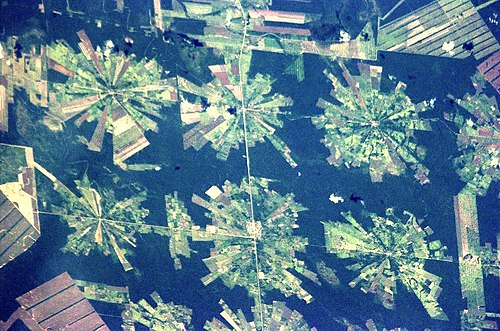 Credit: NASA Orbital photograph of human deforestation in progress in the Tierras Bajas project in eastern Bolivia
WikiProjectsIn the newsAdditional News
Selected biography –Maria Osmarina Marina da Silva Vaz de Lima (born Maria Osmarina da Silva; 8 February 1958), known as Marina Silva, is a Brazilian politician and environmentalist, currently serving as Minister of the Environment and Climate Change, a position she previously held from 2003 to 2008. She is the founder and former spokeswoman of the Sustainability Network (REDE). A former senator for the state of Acre between 1995 and 2011, she has been a federal deputy for the state of São Paulo since 2023. She ran unsuccessfully for president in 2010, 2014 and 2018. Silva was a member of the PT until 2009, and served as a senator before becoming Minister of the Environment in 2003. She ran for president in the 2010 Brazilian elections as the candidate for the Green Party, coming in 3rd with 19% of the first-round vote. In April 2014, Eduardo Campos announced his candidacy for the fall 2014 presidential election, naming Marina Silva as his vice presidential candidate. After Campos's death in a plane crash on August, she was selected to run as the Socialist Party's candidate for the presidency, winning 21% of the vote and coming in 3rd. She again ran for president in the 2018 election, this time as the nominee for the Sustainability Network, finishing in 8th place with 1% of the vote. Silva has won a number of awards from US and international organizations in recognition of her environmental activism. In 2010, she, along with Cécile Duflot, Monica Frassoni, Elizabeth May and Renate Künast, were named by Foreign Policy magazine to its list of top global thinkers for taking Green mainstream. She was one of eight people chosen to carry the Olympic flag for the opening ceremonies of the 2012 London Summer Olympics. (Full article...) General imagesThe following are images from various climate-related articles on Wikipedia.
Did you know –Related portalsSelected panorama –Sea level trends between 1993 and 2010. Per the U.S. National Oceanic and Atmospheric Administration (NOAA), "The following maps provide estimates of sea level rise based on measurements from satellite radar altimeters. The local trends were estimated using data from TOPEX/Poseidon (T/P), Jason-1, and Jason-2, which have monitored the same ground track since 1992.
An inverted barometer has been applied. The estimates of sea level rise do not include glacial isostatic adjustment effects on the geoid, which are modeled to be +0.2 to +0.5 mm/year when globally averaged."
Topics
CategoriesWeb resources
Things to do
WikimediaReferences
Discover Wikipedia using portals
|










